Caloboletus calopus (Pers.) Vizzini - Bitter Beech Bolete
Phylum: Basidiomycota - Class: Agaricomycetes - Order: Boletales - Family: Boletaceae
Distribution - Taxonomic History- Etymology - Identification - Culinary Notes - Reference Sources
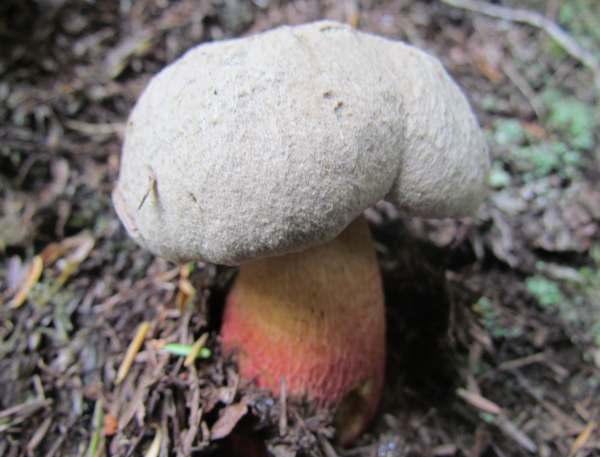
Although Caloboletus calopus is commonly referred to as the Bitter Beech Bolete, it is often found under oak trees as well as under Beech, but nearly always on chalky soil.
The specimens shown here were found in a shallow roadside ditch under mature oaks in Hampshire. Many kinds of fungi, and boletes in particular, seem to fruit with great reliability beneath trees on roadside verges and on the edges of woodland tracks and rides.
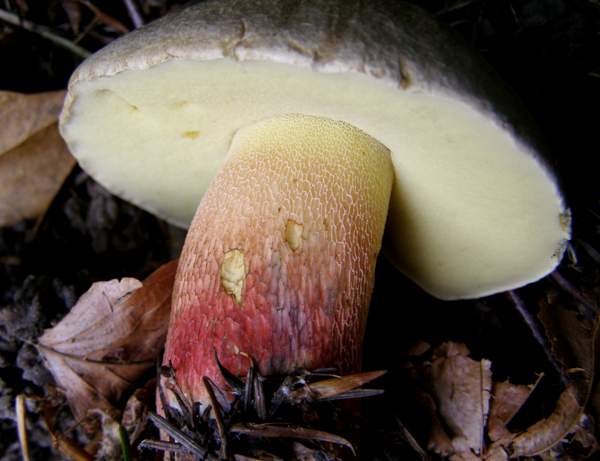
Distribution
Most of the red-stemmed boletes are infrequent finds in Britain and Ireland, but Caloboletus calopus is one of the more common ones. Although its occurrence is occasional and localised, this bolete is most often seen in small groups rather than singly.
The Bitter Beech Bolete is found in many parts of mainland Europe. A very similar bolete occurs in the USA, and there is some debate as to whether it is a subspecies of Caloboletus calopus or a separate species.
In a bolete beauty contest this lovely mushroom would certainly make it to the finals. The exquisite reticulation of the stem against a red background contrasts vividly with the pale yellow of the pores. Another feature to look out for is the greyish-white cap whose pelicle usually overhangs the tubes slightly as in the example above, found in Surrey.
Taxonomic history
Caloboletus calopus was first named and described scientifically in 1801 by Christiaan Hendrik Persoon, who called it Boletus calopus. In 2014 Italian mycologist Alfredo Vizzini transferred this bolete to the new genus Caloboletus based on new DNA findings; its name then became Caloboletus calopus, the type species of this new genus.
Synonyms of Caloboletus calopus include Boletus calopus Pers.
Etymology
The generic name Caloletus comes from the Greekcalo- is derived from Greek Calo- meaning pretty, and -bolos meaning 'lump of clay'. In similar vein, the specific epithet calopus means 'pretty foot' - a reference to the graduated yellow-to red colouring of the reticulate (netted) stem of this mushroom.
Identification guide
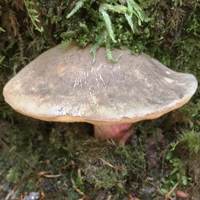 |
Cap5 to 14cm across, often irregularly lobed; various shades of smoky-grey, sometimes with an olivaceous flush, the cap of Caloboletus calopus is initially slightly downy, becoming smooth at maturity; occasionally cracking or developing small scales in the cap centre. |
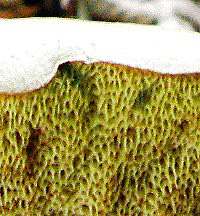 |
Tubes and PoresThe yellow tubes of the Bitter Beech Bolete terminate in tiny yellow pores that turn blue-green when cut or bruised. (Small areas of blueing can be seen in the close-up picture on the left.) |
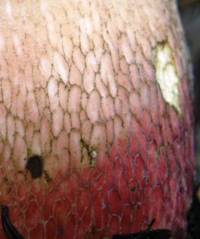 |
Stem7 to 9cm tall and 3 to 5cm in diameter; often curved at base; lemon yellow at the apex and flushed red below, becoming a deeper red at maturity; covered in a pale yellowish net pattern (left). In all but the driest of weather it is not uncommon to find chunks of the stem missing long before a fruitbody has fully developed and taken on its blushing appearance. |
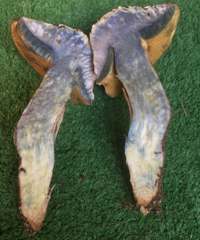 |
Cap and stem fleshThe cap and stem flesh flesh is pale straw yellow, quickly turning white when cut and then later turning a striking turquoise-blue. The yellow tubes turn blue-green when cut and exposed to air. |
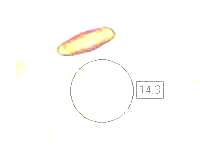 |
Spores12-16 x 4.5-6μm, subfusiform (narrowly spindle-shaped). Spore printOlivaceous snuff-brown. |
Odour/taste |
Bitter taste; strong and unpleasant fungal smell. |
Habitat & Ecological role |
Mainly on alkaline or neutral soil beneath Beech trees and deciduous oaks. In common with other boletes found in Britain and Ireland, Caloboletus calopus is an ectomycorrhizal fungus, which means that it forms symbiotic relationships with the root systems of trees. The Bitter Beech Bolete has been found to associate with pine and spruce trees as well as with its more usual hosts, beeches and oaks. |
Season |
Summer and autumn. |
Similar species |
Suillellus luridus has a darker cap and orange flesh in the stem base; it blues instantly when cut. Rubroboletus satanas has a white cap and orange or red pores when mature; its flesh turns pale blue when cut and then fades back to its original pallid colour. |
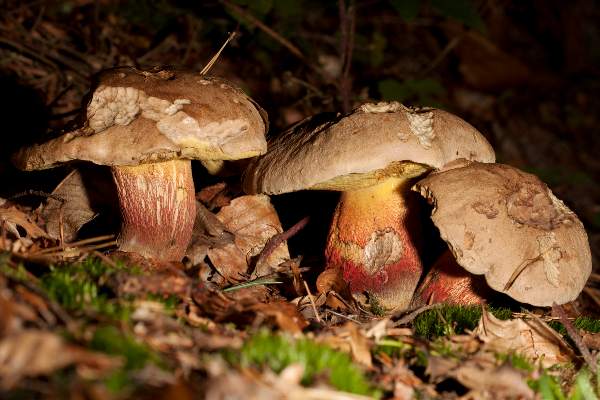
Culinary Notes
The common name of the Bitter Beech Bolete should be sufficient warning: this bolete is not edible, and it could be confused with the more seriously poisonous Rubroboletus satanas.
Reference Sources
Fascinated by Fungi, 2nd Edition, Pat O'Reilly 2016, reprinted by Coch-y-bonddu Books in 2022.
British Boletes, with keys to species, Geoffrey Kibby (self published) 3rd Edition 2012
Roy Watling & Hills, A.E. 2005. Boletes and their allies (revised and enlarged edition), - in: Henderson, D.M., Orton, P.D. & Watling, R. [eds]. British Fungus Flora. Agarics and boleti. Vol. 1. Royal Botanic Garden, Edinburgh.
British Mycological Society English Names for Fungi
Dictionary of the Fungi; Paul M. Kirk, Paul F. Cannon, David W. Minter and J. A. Stalpers; CABI, 2008
Taxonomic history and synonym information on these pages is drawn from many sources but in particular from the British Mycological Society's GB Checklist of Fungi.
Acknowledgements
This page includes pictures kindly contributed by Dave Kelly and Simon Harding.
Fascinated by Fungi. Back by popular demand, Pat O'Reilly's best-selling 450-page hardback book is available now. The latest second edition was republished with a sparkling new cover design in September 2022 by Coch-y-Bonddu Books. Full details and copies are available from the publisher's online bookshop...

